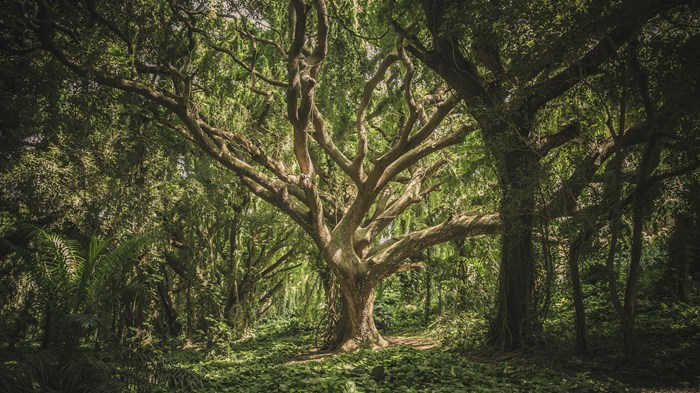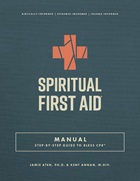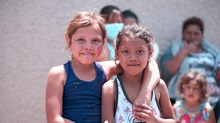What Trees Teach Us about Community and Crisis

Today is Arbor Day in the U.S. — a tree-planting and tree-honoring tradition that began nearly 150 years ago. Throughout history, humans have recognized trees as pillars of strength. They provide the oxygen, nourishment, and resources for life on earth.
But the secret to trees’ strength isn’t simply that they’re the largest and longest-living plants on the planet. They have managed to survive crisis — while helping other creatures to do the same — because they’re literally rooted in community. Today, as our planet faces countless crises, trees have much to teach us.
Far from loners, trees grow as a tight-knit group, intertwined at the roots. But only recently did Western scientists catch on to their communication. Trees in a forest can “talk,” exchanging nutrients, carbon, and water through mycorrhizal networks — a sort of underground internet built by soil fungi. (Some biologists nickname it the “wood wide web.”)
Forests depend on trees’ vast social networks. Older, well-connected “Mother trees” are the community cornerstones that share extra nutrients with younger ones that need them. If two trees are friends, they keep their branches from growing in each other’s way. Collectively, they can regulate the microclimate and air temperature to be just how they like it: cool and damp. Togetherness is a tree’s ticket for survival.
We’d do well to pay attention to our forest elders. Over the past year, I’ve found myself regularly going to a wooded park in Northern Virginia to sit with the oaks and hickories. The 24-acre tract is one of the few old-growth forests left in the area, estimated to be over 100 years old. Right now, Spring’s signs of new life are tangled with signs of death in the park — toppled-over trees with rotten, exposed roots. Erosion across local riverbeds has felled many trees, leaving others standing with just the trunk intact.
Because the roots are interconnected, when one tree dies, the remaining trees often get sick. The tree’s social network could collapse. But the miracle is that dying trees—and even dead trees— continue to be part of the forest community. When a tree falls victim to natural disaster or disease, it can warn its neighbors through the social network so they don’t meet the same fate. When trees are cut, they send electrical signals like wounded human tissue. And some stumps, still connected at the roots, can keep sharing their wisdom to help the forest flourish, some scientists say. Our woods, just like the rest of the world, are rooted in relationships.
Humans and trees have much in common. After all, our own lungs look much like trees, and trees are sometimes called “the lungs of the earth.” In fact, the connection between humans and trees is a recurring theme in the Hebrew Bible. Trees and humans are repeatedly found together, linked by the same key words, images and scenes (as pointed out in The Bible Project). Trees are mentioned more than any other living thing, except for people and God— from the first page of Genesis to the last page of Revelation. God chose trees as his symbol of life: a source of wholeness, healing, and abundance.
Yet humans did not choose the way of the Tree of Life. Today our world is painfully fragmented. When I sit with the dead trees at my local park, mourning the larger loss brought by climate change, development, and deforestation, I remember the Tree of the Knowledge of Good and Bad — the one we picked because we craved control, rather than staying within our natural limits. While we've been filling the air with toxins, trees have continued to purify it, absorbing harmful carbon emissions and breathing out the very oxygen we need to survive.
As we celebrate Arbor Day while grappling with grave environmental, health, and economic challenges, trees call us towards a community rooted in care. We must not think only of our own wellbeing, but our neighbors’. We must anchor ourselves in strong social networks that nurture solidarity. We must remember that our survival depends on sharing. We must preserve and share the wisdom of our elders and those who have passed on. We must learn how to transform our society’s toxins— misinformation, polarization, violence, prejudice—by releasing the air of heaven, full of peace, love, and justice.
Christians, along with many other people of faith, believe the Earth will be healed and made whole again. We see the Tree of Life reappear in Revelation, calling us towards a way of walking with God and experiencing the world as he intended it. Let’s listen to the trees, joining together to root ourselves fully in the work of restoration.
Sarah Holcomb covers faith and social and environmental movements. She is the editor for Changemakers, an online publication of Ashoka, as well as a freelance journalist whose work has been featured in CT, The New Humanitarian, Next City, and others. Sarah graduated from Wheaton College (IL), where she studied journalism and Human Needs and Global Resources, and currently lives in the D.C. area.
The Better Samaritan is a part of CT's
Blog Forum. Support the work of CT.
Subscribe and get one year free.
The views of the blogger do not necessarily reflect those of Christianity Today.




















